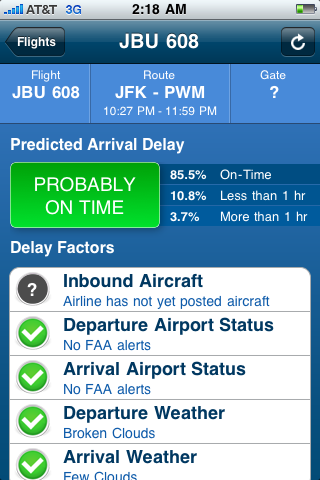A month ago this upcoming weekend, I got massively delayed out of Portland, blew a connection in JFK and missed a wedding in Denver. This won’t surprise anyone who knows me or is a regular around here: I never get anywhere on time.
What was different this time was the fact that I used an iPhone application that I’d bought, built by a Y Combinator backed startup, that was supposed to algorithmically predict all of the above. Unfortunately, this trip out at least, it failed. But the user experience wasn’t all bad, as I’ll get to.
The basic premise is this: the application inputs a variety of data – departure and arrival airport statuses and weather, inbound aircraft location and so on – runs the numbers and gives you a best guess as to whether or not you’ll be delayed. Great idea, in my opinion.
Anyway, when we arrived at the airport, I was greeted by this screen.
That, for those of you not in the business, is what we call suboptimal. Still, when I turned to FlightCaster, it asserted that I was “Probably on Time.” Which would have been great news; I wanted to get to Denver both for the wedding and to see all of my friends out there.
The only catch was that it continued to assert this long after we were delayed.
Note the timestamp at the top of the screen. Worse, for FlightCaster, it had exactly the same trouble when we gave up and decided to return back to Portland.

Almost three hours after we were supposed have taken off but hadn’t, FlightCaster was still saying that we were “Probably on Time.” That’s a bit of a problem, I think.
The good news in all of this is that in spite of the applications failure and a disastrous twelve hours spent flying to and from New York, one of the FlightCaster developers picked up on my comments on Twitter and was both immediately responsive and apologetic. Which made a big difference.
Was I happy that I’d spent $4.99 on an application that failed? Not at all. But the ability to interact with one of the people building it made a difference in my perception of the application.
I still can’t recommend it, but I’ll continue using it and might change my opinion at some point in the future. Which is pretty much all you could hope for given the quality of the initial experience.


